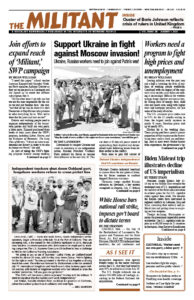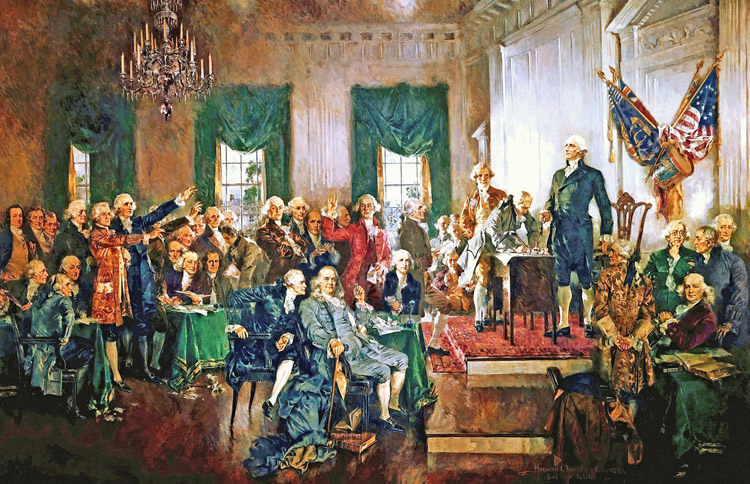One of Pathfinder’s Books of the Month for July is America’s Revolutionary Heritage: Marxist Essays by George Novack. A long-time leader of the Socialist Workers Party, he wrote a number of books on questions of Marxist politics and history. The excerpts from the book are from “How the Constitution Was Written” and “Mercy Otis Warren — Mother of the American Revolution.” Growing out of the American revolutionary war for independence from British colonial rule, an uprising began by indebted farmers in Massachusetts against government oppression — Shays’ rebellion. It helped lead to adoption of the U.S. Constitution and the Bill of Rights, which provides protections against the state that working people continue to need today. Copyright © 1976 by Pathfinder Press. Reprinted by permission.
In the previous essay we outlined the role of the northern merchants and the southern planters in the struggle of the American colonies for independence. If we follow the coalition to the next great stage of its work, we find it in the unification of the nation under the Constitution. At this stage, however, the lead in the coalition changes hands and the merchants become the more aggressive and dominant element.
The cause of this shift is easily traced. The merchant class stood in need of a strong national government far more urgently than its ally in the coalition. Its need was lodged in the classic motivations that have everywhere caused the bourgeoisie to accomplish the task of national unification.
* * *
From the outbreak of Shays’s Rebellion in 1786 until the adoption of the Constitution of the United States three years later, Mercy Otis Warren once more undertook to organize in defense of the American Revolution. Along with James Warren and Elbridge Gerry, she opposed a federal constitution that did not guarantee any rights to its citizens. The oppositional pamphlet Observations on the New Constitution, and on the Federal Conventions was published in Boston in 1788 by “a Columbian Patriot.” Traditionally attributed to Gerry, the pamphlet is now accepted as the work of Mercy Otis Warren.
By the time the Constitution was drafted, the men of property desired a strong central government that could quell local disturbances such as Shays’s Rebellion. Protection of property was uppermost in their minds. As Mercy wrote to her English friend, the Anti-Federalists “wish for a union of the States on the free principles of the late Confederation” while the Federalists “are for the consolidation of a strong government on any or on new principles; and are for supporting it by force, at the risk of distorting the fairest features in the political face of America.” As Mercy Warren outlined in her pamphlet, the Anti-Federalists objected primarily to the lack of democratic guarantees in the Constitution; there was no provision for the right of freedom of the press, the right of conscience, or the right to a trial by jury. The proposed document did not outline basic civil liberties and would not protect the individual from such measures as the odious writs of assistance. …
While the Federalists vaguely promised the possibility of constitutional amendments, the Anti-Federalists, including James and Mercy Otis Warren, demanded a bill of rights. As Mercy put it, “The very suggestion that we ought to trust to the precarious hope of amendment and redress, after we have voluntarily fixed the shackles on our own necks, should have awakened us to a double degree of caution.”
When Thomas Jefferson worked out the Bill of Rights, the Anti-Federalists agreed to support the Constitution.
* * *
Sharp rebellion in Massachusetts and the capture of the Rhode Island state government by the indebted farmers had just served notice on the ruling classes of the precariousness of their position in the face of the rising popular clamor. This notice was served in the South as well as the North; we have [James] Madison’s authority to authenticate the stories of rebellion in Virginia. That the planters shared the alarm of the merchants at these storm signals, and that they moved to form a strong central government capable of helping the states to maintain propertied rule, is indubitable. …
We now enter upon one of the most amazing chapters in American history. For the first time in close to three decades the planter-merchant coalition that ruled the country was broken. In a brilliant and vigorous stroke the northern bourgeoisie took independent possession of the state power and, for a turbulent decade, used it like a pile driver to sink the foundations of American capitalism. …
[Alexander] Hamilton’s system was unified by a single conception: the establishment of the rule of the bourgeoisie. …
Hamilton’s program met with violent opposition from the farmers and their representatives, many of whom had opposed the adoption of the Constitution. Gradually, as they realized that the coalition was entirely ruptured by the audacious Hamilton, the large planters under the lead of Jefferson, Madison, [James] Monroe, and similar figures went into opposition. A great battle opened that was to shake the nation to its roots during the next decade.
The agricultural interests were quick to realize that the work of the first administration was conducted entirely in behalf of the mercantile interests, and, further, that it would pay for itself out of taxes and higher prices borne by the agricultural population, who constituted 90 percent of the country. Stung to fury, they launched a tenacious offensive under the able guidance of Jefferson. In this they had every advantage. The revolutionary ferment [of 1776], not yet subsided, was aroused to a wave of leveling radicalism by the stirring news from France [1789 French Revolution].


